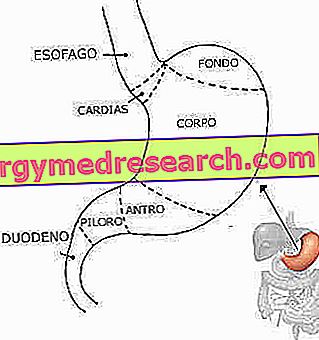Introduction to Vitamins
Vitamins are essential molecules in small quantities, both for the life of animals and for that of plants; they do not supply energy but perform functions of primary importance:
- Development of the growing organism
- Bioregulating function
- Coenzyme precursors or constituents
Vitamins can be classified according to their chemical and physical characteristics; the most traditional differentiation is that of solubility (water-soluble vitamins and fat-soluble vitamins), but there are also distinctions on the molecular resistance to heat (thermolabile vitamins and thermostable vitamins), on the reactivity to light (photosensitive vitamins and photoresistants vitamins) etc.

Vitamins - how many to take?
The total (or nearly so) DEFICIENCY of vitamins is called avitaminosis, while the partial one is called hypovitaminosis ; on the other hand, the EXCESS of vitamins can also determine toxicity reactions defined as hypervitaminosis .
As anticipated, vitamins are a group of MICRO-nutrients that boasts a wide range of functions; it follows that, by virtue of their heterogeneity, even their metabolic demand differs significantly between the molecules. Simply put, the recommended rations of vitamins are all different.
Recommended rations of vitamins
Vitamins must be taken according to the needs of the body; these differ significantly based on sex, age, special physiological conditions, pathological conditions, physical activity, etc.
To meet the needs of the general population, the various research institutes have carried out numerous studies, both experimental and statistical; certainly, the most authoritative bibliographic sources are the American RDAs (Recommended Daily Allowance) and the Italian LARNs (Recommended Levels of Intake of Nutrients for the Italian population, composed and modified by the SINU: Italian Human Nutrition Society); therefore, to the question "How many vitamins do you take?", we will respond with the values disclosed by our national body: the LARN of SINU
| Vitamins | infants | children | males | Females | expectant | Nourish | ||||||||||
| Age (years) | 0, 5-1 | 1-3 | 4-6 | 7-10 | 11-14 | 15-17 | 18-29 | 30-59 | 60+ | 11-14 | 15-17 | 18-29 | 30-49 | 50+ | ||
| A (µg) | 350 | 400 | 400 | 500 | 600 | 700 | 700 | 700 | 700 | 600 | 600 | 600 | 600 | 600 | 700 | 950 |
| D (µg) | 10-25 | 10 | 0-10 | 0-10 | 0-15 | 0-15 | 0-10 | 0-10 | 10 | 0-15 | 0-15 | 0-10 | 0-10 | 10 | 10 | 10 |
| E (mg) | 1.8 | 1.88 | 2.0 | 2.0 | 2.4 | 10, 52 | 10, 52 | 10, 52 | 10, 52 | 2.0 | 2.4 | 2.2 | 2.2 | 2.6 | 2.4 | 2.6 |
| K (µg) | 7-10 | 9-16 | 16-22 | 23-33 | 35-53 | 55-66 | 65 | 65 | 65 | 35-51 | 52-55 | 56 | 56 | 56 | > 56 | > 56 |
| F (ω3 + ω6) (g) | 4.5 | 4.7 | 5 | 5 | 6 | 7.5 | 7.5 | 7.5 | 7.5 | 5 | 6 | 5.5 | 5.5 | 6.5 | 6 | 6.5 |
| C (mg) | 35 | 40 | 45 | 45 | 50 | 60 | 60 | 60 | 60 | 50 | 60 | 60 | 60 | 60 | 70 | 90 |
| B1 (mg) | 0.4 | 0.6 | 0.7 | 0.9 | 1.1 | 1.2 | 1.2 | 1.2 | 0.8 | 0.9 | 0.9 | 0.9 | 0.9 | 0.8 | 1 | 1.1 |
| B2 (mg) | 0.4 | 0.8 | 1.0 | 1.2 | 1.4 | 1.6 | 1.6 | 1.6 | 1.6 | 1.2 | 1.3 | 1.3 | 1.3 | 1.3 | 1.6 | 1.7 |
| B3 / PP (mg) | 5 | 9 | 11 | 13 | 15 | 18 | 18 | 18 | 18 | 14 | 14 | 14 | 14 | 14 | 14 | 16 |
| B5 (mg) | 3-12 | 3-12 | 3-12 | 3-12 | 3-12 | 3-12 | 3-12 | 3-12 | 3-12 | 3-12 | 3-12 | 3-12 | 3-12 | 3-12 | 3-12 | 3-12 |
| B6 (mg) | 0.4 | 0.7 | 0.9 | 1.1 | 1.3 | 1.5 | 1.5 | 1.5 | 1.5 | 1.1 | 1.1 | 1.1 | 1.1 | 1.1 | 1.3 | 1.4 |
| B8 or H (mg) | 15-100 | 15-100 | 15-100 | 15-100 | 15-100 | 15-100 | 15-100 | 15-100 | 15-100 | 15-100 | 15-100 | 15-100 | 15-100 | 15-100 | 15-100 | 15-100 |
| B.C. Folic (µg) | 50 | 100 | 130 | 150 | 180 | 200 | 200 | 200 | 200 | 180 | 200 | 200 | 200 | 200 | 400 | 350 |
| B12 (µg) | 0.5 | 0.7 | 1 | 1.4 | 2 | 2 | 2 | 2 | 2 | 2 | 2 | 2 | 2 | 2 | 2.6 | 2.6 |
The above scheme is almost the same as that of the LARNs; however, some values (such as those of vitamin E and vitamin K) are the result of arithmetic products between unitary coefficients and other reference parameters (such as the total contribution of vitamin F [essential fatty acids - AGE] or weight "physiological" body) suggested by the text itself.
Further information on recommended vitamin rations
We also recall that vitamin PP is expressed as Niacin Equivalent (NE) because it also includes endogenous vitamin B3 synthesized from tryptophan (1 mg every 60 mg of tryptophan); to have a more precise calculation of the recommended intake of vitamin PP the following arithmetic operation should be performed:
- dietary PP mg = 6.6 per 1000kcal introduced with the diet = 6.6 * (kcal with the diet / 1000) .
The same indications can be applied to vitamins B1 and B2, through the products:
- mg of B1 with the diet = 0.4 per 1000 kcal introduced with the diet = 0.4 * (kcal with the diet / 1000)
- mg of B2 with the diet = 0.6 per 1000 kcal introduced with the diet = 0.6 * (kcal with the diet / 1000)
The proportion of vitamin B6 is calculated on the basis of 15 mg / gram (g) of protein (about 15% of energy intake is protein in both children and adults).
Vitamin A is in µg of Retinol Equivalents, but remember that 1µg of retinol = 6 µg of beta-carotene = 12 µg of other active carotenoids (NB. Attention to vitamin A supplementation in pregnancy!).
To cover the needs of vitamin D it is sometimes necessary to use fortified foods or supplement with supplementary supplementation.



